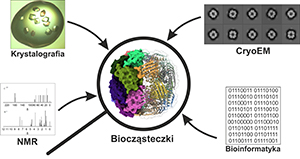Advancements in Structural Biology – How to See Molecules of Life?
DOI:
https://doi.org/10.18388/pb.2021_533Abstract
Structural biology is focused on understanding the architecture of biomolecules, such as proteins and nucleic acids. Deciphering the structure helps to understand their function in the cell at a very precise – molecular level. This makes it possible to not only determine the basis of diseases but also to propose therapeutic strategies and tools. Such a strong motivation for the development of structural biology has led to the development of a number of methods, which enable determination of the structures of the molecules of life. The continuous progress has been enabled by the integration of biology, chemistry, physics, and computer science, making structural biology extremely interdisciplinary.
In its 35-year history, the Institute of Bioorganic Chemistry of the Polish Academy of Sciences in Poznan has become one of the key Polish institutions conducting research in the field of structural biology. On one hand, the research has brought international recognition, and on the other hand, it has forced the implementation and development of cutting-edge methods. This review discusses the methods used in structural biology at the Institute.

Published
License
Copyright (c) 2024 Wojciech Witek, Wiktoria Ragin, Ha Linh Tran, Ewa Połomska, Mikołaj Podlewski, Aleksandra Pawłowicz, Aleksandra Cioch-Biniaś, Amadeusz Woś, Witold Andrałojć, Marta Szachniuk, Miłosz Ruszkowski

This work is licensed under a Creative Commons Attribution 4.0 International License.
All journal contents are distributed under the Creative Commons Attribution-ShareAlike 4.0 International (CC BY-SA 4.0) license. Everybody may use the content following terms: Attribution — You must give appropriate credit, provide a link to the license, and indicate if changes were made, ShareAlike — If you remix, transform, or build upon the material, you must distribute your contributions under the same license as the original. There are no additional restrictions — You may not apply legal terms or technological measures that legally restrict others from doing anything the license permits.
Copyright for all published papers © stays with the authors.
Copyright for the journal: © Polish Biochemical Society.



